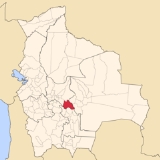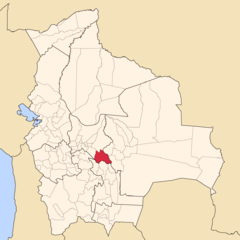
Narciso Campero Province
Encyclopedia
| Location of Narciso Campero Province within Bolivia | |
|---|---|
 |
|
| General Data | |
| Country |  Bolivia BoliviaBolivia Bolivia officially known as Plurinational State of Bolivia , is a landlocked country in central South America. It is the poorest country in South America... |
| Departament Departments of Bolivia Bolivia is divided into nine departments . Each of the departments is subdivided into provinces , which are further subdivided into municipalities .... |
Cochabamba Department Cochabamba Department Cochabamba is one of the nine component departments of Bolivia. It is known to be the "granary" of the country because of its variety of agricultural products due to Cochabamba's geographical position. It has an area of 55,631 km². Its population, in the 2007 census, was 1,750,000... |
| Capital | Aiquile Aiquile Aiquile is a town in the Cochabamba Department, Bolivia. It is the capital of the Narciso Campero Province and Aiquile Municipality. Most of its population is Quechua, and its residents are reputed to be the best charango makers in the country.... |
| Municipalities Municipalities of Bolivia Municipalities in Bolivia are administrative divisions of the entire national territory governed by local elections. Municipalities are the third level of administrative divisions, below departments and provinces. Some of the provinces consist of only one municipality... |
3 |
| Cantons Cantons of Bolivia ||On the level below municipalities, Bolivia is divided into cantons .... |
10 |
| Area Area Area is a quantity that expresses the extent of a two-dimensional surface or shape in the plane. Area can be understood as the amount of material with a given thickness that would be necessary to fashion a model of the shape, or the amount of paint necessary to cover the surface with a single coat... |
5,550 km² |
| Elevation Elevation The elevation of a geographic location is its height above a fixed reference point, most commonly a reference geoid, a mathematical model of the Earth's sea level as an equipotential gravitational surface .... |
m |
| Population Population A population is all the organisms that both belong to the same group or species and live in the same geographical area. The area that is used to define a sexual population is such that inter-breeding is possible between any pair within the area and more probable than cross-breeding with individuals... |
37,011 (2001) |
| Density Density The mass density or density of a material is defined as its mass per unit volume. The symbol most often used for density is ρ . In some cases , density is also defined as its weight per unit volume; although, this quantity is more properly called specific weight... |
6.7 inhabitants/km² (2001) |
| Sub-prefect | |
| Language Language Language may refer either to the specifically human capacity for acquiring and using complex systems of communication, or to a specific instance of such a system of complex communication... s |
Quechua Quechua languages Quechua is a Native South American language family and dialect cluster spoken primarily in the Andes of South America, derived from an original common ancestor language, Proto-Quechua. It is the most widely spoken language family of the indigenous peoples of the Americas, with a total of probably... , Spanish Spanish language Spanish , also known as Castilian , is a Romance language in the Ibero-Romance group that evolved from several languages and dialects in central-northern Iberia around the 9th century and gradually spread with the expansion of the Kingdom of Castile into central and southern Iberia during the... |
| ISO 3166-2 ISO 3166-2 ISO 3166-2 is part of the ISO 3166 standard published by the International Organization for Standardization , and defines codes for the names of the principal subdivisions of all countries coded in ISO 3166-1... |
BO.CB.CM |
| Cochabamba Department | |
 |
|
Narciso Campero is a province
Province
A province is a territorial unit, almost always an administrative division, within a country or state.-Etymology:The English word "province" is attested since about 1330 and derives from the 13th-century Old French "province," which itself comes from the Latin word "provincia," which referred to...
in the Cochabamba Department
Cochabamba Department
Cochabamba is one of the nine component departments of Bolivia. It is known to be the "granary" of the country because of its variety of agricultural products due to Cochabamba's geographical position. It has an area of 55,631 km². Its population, in the 2007 census, was 1,750,000...
, Bolivia
Bolivia
Bolivia officially known as Plurinational State of Bolivia , is a landlocked country in central South America. It is the poorest country in South America...
. Its capital is Aiquile
Aiquile
Aiquile is a town in the Cochabamba Department, Bolivia. It is the capital of the Narciso Campero Province and Aiquile Municipality. Most of its population is Quechua, and its residents are reputed to be the best charango makers in the country....
. Aiquile lies on one transportation route between the citys of Cochabamba
Cochabamba
Cochabamba is a city in central Bolivia, located in a valley bearing the same name in the Andes mountain range. It is the capital of the Cochabamba Department and is the fourth largest city in Bolivia with an urban population of 608,276 and a metropolitan population of more than 1,000,000 people...
, Sucre
Sucre
Sucre, also known historically as Charcas, La Plata and Chuquisaca is the constitutional capital of Bolivia and the capital of the department of Chuquisaca. Located in the south-central part of the country, Sucre lies at an elevation of 2750m...
and Santa Cruz
Santa Cruz de la Sierra
Santa Cruz de la Sierra, commonly known as Santa Cruz, is the capital of the Santa Cruz department in eastern Bolivia and the largest city in the country...
.
Subdivision
The province is divided into three municipalitiesMunicipalities of Bolivia
Municipalities in Bolivia are administrative divisions of the entire national territory governed by local elections. Municipalities are the third level of administrative divisions, below departments and provinces. Some of the provinces consist of only one municipality...
which are further subdivided into cantons.
| Section | Municipality | Seat |
|---|---|---|
| 1st | Aiquile Municipality Aiquile Municipality Aiquile Municipality is the first municipal section of the Narciso Campero Province in the Cochabamba Department, Bolivia. Its seat is Aiquile.- Cantons :The municipality is divided into three cantons... |
Aiquile Aiquile Aiquile is a town in the Cochabamba Department, Bolivia. It is the capital of the Narciso Campero Province and Aiquile Municipality. Most of its population is Quechua, and its residents are reputed to be the best charango makers in the country.... |
| 2nd | Pasorapa Municipality Pasorapa Municipality Pasorapa Municipality is the second municipal section of the Narciso Campero Province in the Cochabamba Department, Bolivia. Its seat is Pasorapa.- Cantons :The municipality consists of only one canton, Pasorapa Canton. It is identical to the municipality.... |
Pasorapa Pasorapa Pasorapa, which comes from paso rápido, , is a small town in Bolivia located in the southeast of the department of Cochabamba. Pasorapa lies at an elevation of 2,364 m. At the time of census 2001 it had a population of 1,114... |
| 3rd | Omereque Municipality Omereque Municipality Omereque Municipality is the third municipal section of the Narciso Campero Province in the Cochabamba Department, Bolivia. Its seat is Omereque.- Cantons :The municipality is divided into six cantons... |
Omereque Omereque Omereque is a location in the Cochabamba Department in central Bolivia. It is the seat of the Omereque Municipality, the third municipal section of the Narciso Campero Province.... |
1998 Earthquake
Campero was the epicenterEpicenter
The epicenter or epicentre is the point on the Earth's surface that is directly above the hypocenter or focus, the point where an earthquake or underground explosion originates...
of an earthquake which struck on 1998-05-22. The earthquake with a force of 6.6 on the Richter scale caused over 100 deaths and thousands were left homeless. It was the largest shallow earthquake in Bolivia in over 50 years, and was felt as far away as
Cochabamba
Cochabamba
Cochabamba is a city in central Bolivia, located in a valley bearing the same name in the Andes mountain range. It is the capital of the Cochabamba Department and is the fourth largest city in Bolivia with an urban population of 608,276 and a metropolitan population of more than 1,000,000 people...
and Sucre
Sucre
Sucre, also known historically as Charcas, La Plata and Chuquisaca is the constitutional capital of Bolivia and the capital of the department of Chuquisaca. Located in the south-central part of the country, Sucre lies at an elevation of 2750m...
(approximately 100 km).
The earthquake caused widespread damage over an area of approximately 100 km in diameter. The major towns affected were Hoyadas (100% of the buildings destroyed), Aiquile (75% of the buildings destroyed) and Totora
Totora, Cochabamba
Totora is a town in the Cochabamba Department, Bolivia. It is the seat of the Carrasco Province....
(70% of the buildings
destroyed).

